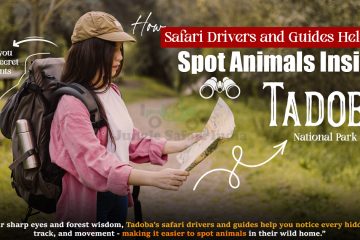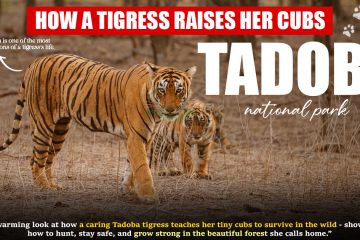Tadoba National Park is a beautiful spot in Maharashtra, which is home to a lot of animals like tigers, leopards, deer, wild boars, sloth bears, and many more. This park is filled with species of trees, plants, grasslands, and lakes, and is a safe spot for birds of different kinds. For all the animals, birds, and flora, water is extremely important.
Just like humans need water to drink, cook, wash, and stay alive, animals also need water every single day. Without water, they cannot survive. But sometimes Tadoba faces water problems, especially during the hot summer months. In summer, the whole area of Tadoba National Park becomes hot, and the temperature can go above 45°C. This results in drying up of small bonds, streams, and also the grass and plants lose moisture. This situation is called water scarcity, which basically means not having enough water around.
When the water problem comes, the forest becomes dry and dusty. Animals start feeling thirsty more quickly. This is when their movement begins to change. They mostly change the way they move, travel, eat, hunt, and live inside the park. This blog explains how the water problems shape animal movement inside the Tadoba National Park.Â
Why Water is Important
Water is a basic need for everyone. Humans need water for drinking, cooking, washing, staying alive, and many other things. Just like humans, plants also need water to grow and live. And, the animals need water for drinking, cooling their bodies, digesting food, staying healthy, and to keep their energy.
The survival of humans, animals, and plants depends on water, and when it becomes difficult to be found, the animals of Tadoba make their choices.
How Water Affects Animal Movement
Animal Move Close to Water Sources
When there is water scarcity, especially during the summer season, the first big change that happens is that animals start staying close to water sources. Most of the animals of the park start sharing the same boundaries, like deer, wild boar, tigers, monkeys, birds, sambar, and bison, along with others.
Normally, these animals remain distributed inside the park, and they do not share the same boundaries. But, because of water scarcity, most of them gather in only a few places where water is still available. These water spots become the busiest areas in the forest.
Animal Travel Longer Distances
When the small water holes of the park dry up, animals walk for longer distances to find water. For example – a deer may walk for kilometers in search of water, or a tiger might change its territory for better water access. This long travel takes more energy from the animals, and for it, they need more food and strength.
Because of this long travel, animals also become more tired and weaker. They have to spend a lot of time and energy walking. Sometimes, they also have to cross areas that are not safe, where other stronger animals may attack them. But this becomes a thrill for people who want to enjoy sightings of animals during their Tadoba safari. You might even catch the animals hunting inside the park if you visit in summer. However, this situation shows how difficult life becomes for animals when water is not easily found.
Animal Change Their Daily Routine
It becomes difficult for animals to walk in the heat of the sun, so most animals even change their daily schedules. During the morning and evening hours, they are spotted more because they walk more to drink water and search for food when it is cooler. They rest under the shade during the afternoon time and they become most active at night.
If you’re making a Tadoba Safari Booking for summer, then choosing the morning ride would be best for you. Morning safari might offer better chances of animal sightings inside the Tadoba because the area remains cool during morning hours. Tigers and leopards hunt more during early morning because their bodies need to save energy and stay cool. So, you might get a chance to enjoy animal sightings easily inside Tadoba National Park.
Safari Experience Becomes More Adventurous
One of the best things about water scarcity is that many animals remain in the same area where water is available. For tourists, this becomes a wonderful moment when they go on the Tadoba Safari. Because of the water scarcity, animals are easily spotted. You can see them walking towards water or resting, playing, or drinking from them.
From your thrilling gypsy safari, you might spot deer drinking water, langurs resting near the waterhole areas, or tigers sitting in the mud to cool down. When water problems arise, all animals depend on the same water source and live around each other without disturbing the balance of nature.
When tourists know how water shapes animal movement, they enjoy the safari in a deeper way. Instead of just waiting to spot a tiger, they start noticing animals moving in particular directions and birds making the warning calls. They also stay at the waterhole areas for a longer time, as animals are spotted easily there. This whole thing makes the safari experience more meaningful, and it allows the tourist to connect with nature on a deeper level.
Final Thoughts
Water is an important part of the Tadoba. The presence or absence of water changes the movement, behaviour, safety, and survival of all animals that call this park home. Most of the guides who go on safari with tourists understand the movements and habits of animals. They can see the fresh animal trucks, know the bird alarm calls, and they can even tell you which is the nearest water body to your location.Â
The guides and drivers of Tadoba safari use their knowledge to help tourists see wildlife. Water movement plays a huge role in deciding which route you should prefer for a thrilling safari ride inside the park. We always advise tourists to make their Tadoba Safari Booking for the zones in which there are more water bodies, especially during the summer season.



0 Comments